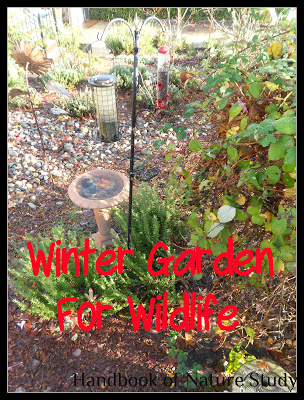Now that the season has changed and we have cleaned up the yard for the coming season, I thought I would share a few of the ways we keep our yard as a wildlife habitat in winter. It is just a matter of knowing which plants to prune back and which ones can be left as they are.
We have learned by trial and error mostly.
The Heavenly bamboo along the front of our house is not only colorful this time of year with the leaves turning reddish and the berries ripening to a brilliant orange-red but it is a source of shelter for birds and insects. I have seen the Ruby-crowned kinglet gathering spiderwebs from these bushes. (Audubon website says of the kinglet’s nest, “Moss, grass, lichen, bark strips, twigs, rootlets, needles, and spider webs comprise its outer walls, and feathers, plant down, and hair form a soft lining.”)
We leaves some of the grasses and weeds for the birds and other animals to use as food and shelter.
They don’t look very appetizing but the birds think these are tasty little treats….blackberries left on the vine just behind our bird feeding station. The finches, sparrows, titmouse, and towhees all shelter on and under these vines. I also saw fox scat just by these vines last week so I think they might be gleaning a few berries as well (as evidenced in the scat).
The coneflowers are another favorite in the winter flower garden. I cut them way back but leave some of the seed heads for the birds to glean from.
We also have learned that some of the weeds in our yard are best left to over-winter. These mullein plants will shoot up a stalk next spring and then flower all summer. The hummingbirds and finches will use them as a steady part of their diet. We leave those in the garden.
I harvested about thirty pounds of walnuts this year for our enjoyment. I will spend many a winter evening hour cracking nuts for our family and to share with friends. Some of those friends will have feathers and fur. I leave quite a few of the nuts for the squirrels and Scrub jays to use for their winter meals. When I note that all the nuts are up off the ground, I will regularly set some out of my store cupboard in various parts of the yard. They always disappear.
Lavender along the front wall is once place I trim but not all the way back. It looks sort of wild but it does provide shelter all winter long for birds and nectar for the hummingbirds and bees. Yes, we have bees and hummingbirds in the winter who frequent this section of the garden. It amazes me every time I see the birds hovering over those small little flowers but they must be gathering some food or they wouldn’t come back. I also love leaving this section of lavender because when the sun hits those plants it produces a sweet smell that reminds me that summer will come again.
It can’t all be about the animals, birds, and insects.
I have another post that I will share in the next few weeks showing some more sheltering spots in our yard that may inspire you to try your hand at a winter garden for wildlife.
I invite you to read Winter Garden for Wildlife Part 2 – Shelter.


I love this idea, but the few times we have put up a birdfeeder, we have attracted mice. :/ We live across the street from a large field, which means we have lots of sightings of hawks, vultures, etc., but also a potential mice problem. Thankfully, we don’t ever see them around unless we leave something out for the birds…but this has meant an end to our bird feeding. We also don’t have pets and don’t plan to–I know that could be a deterrent for rodents, but it’s not a possibility for us. Any suggestions? Have you ever run into this problem leaving walnuts out and whatnot? I would love to make our yard more wildlife-friendly, but I must admit, I really would rather *that* kind of wildlife stay far, far away. 😉
We have had rodents, mice and voles that eat under our feeders. We do have cats and a dog so they mostly come at night when the pets are inside.
As far as the walnuts, I leave them in the shell for the birds and squirrels so as far as I know, the rodents don’t eat them.
Most of what we do to attract wildlife is to use our landscaping as food and shelter. The bird feeders are just part of the whole picture.